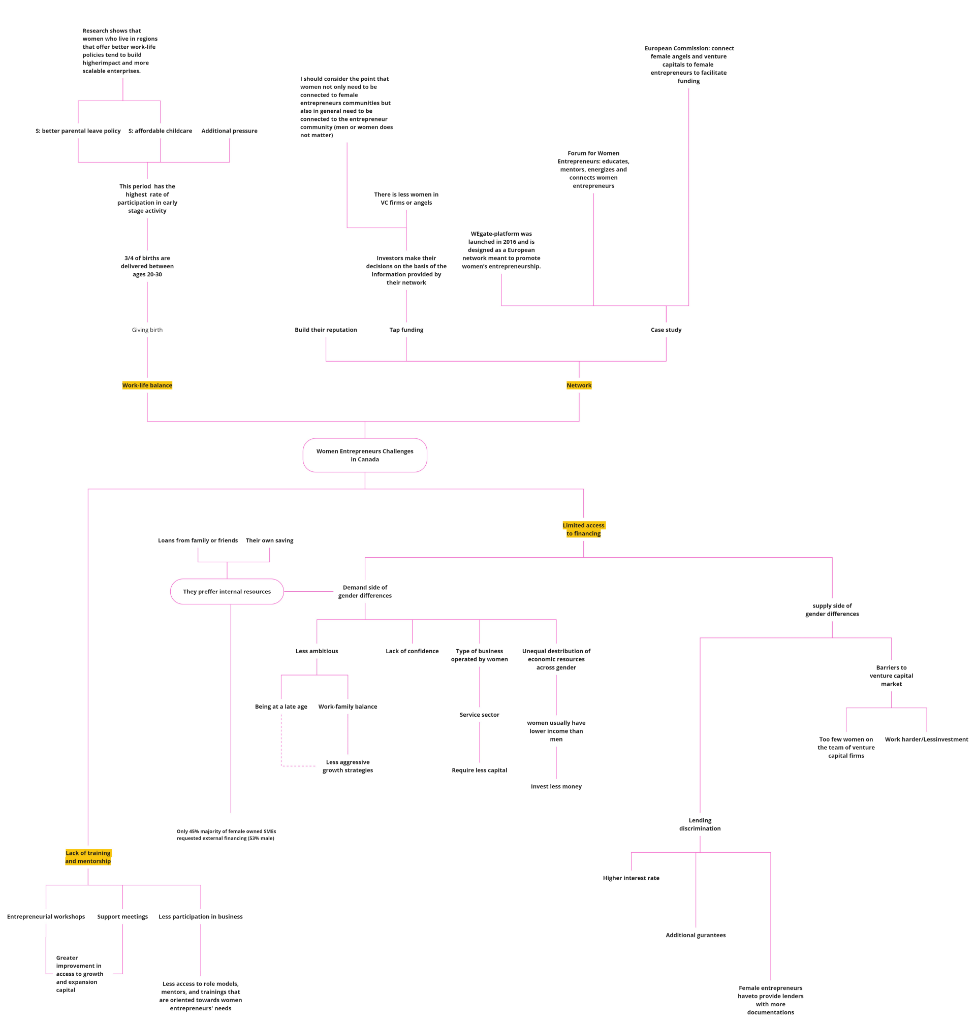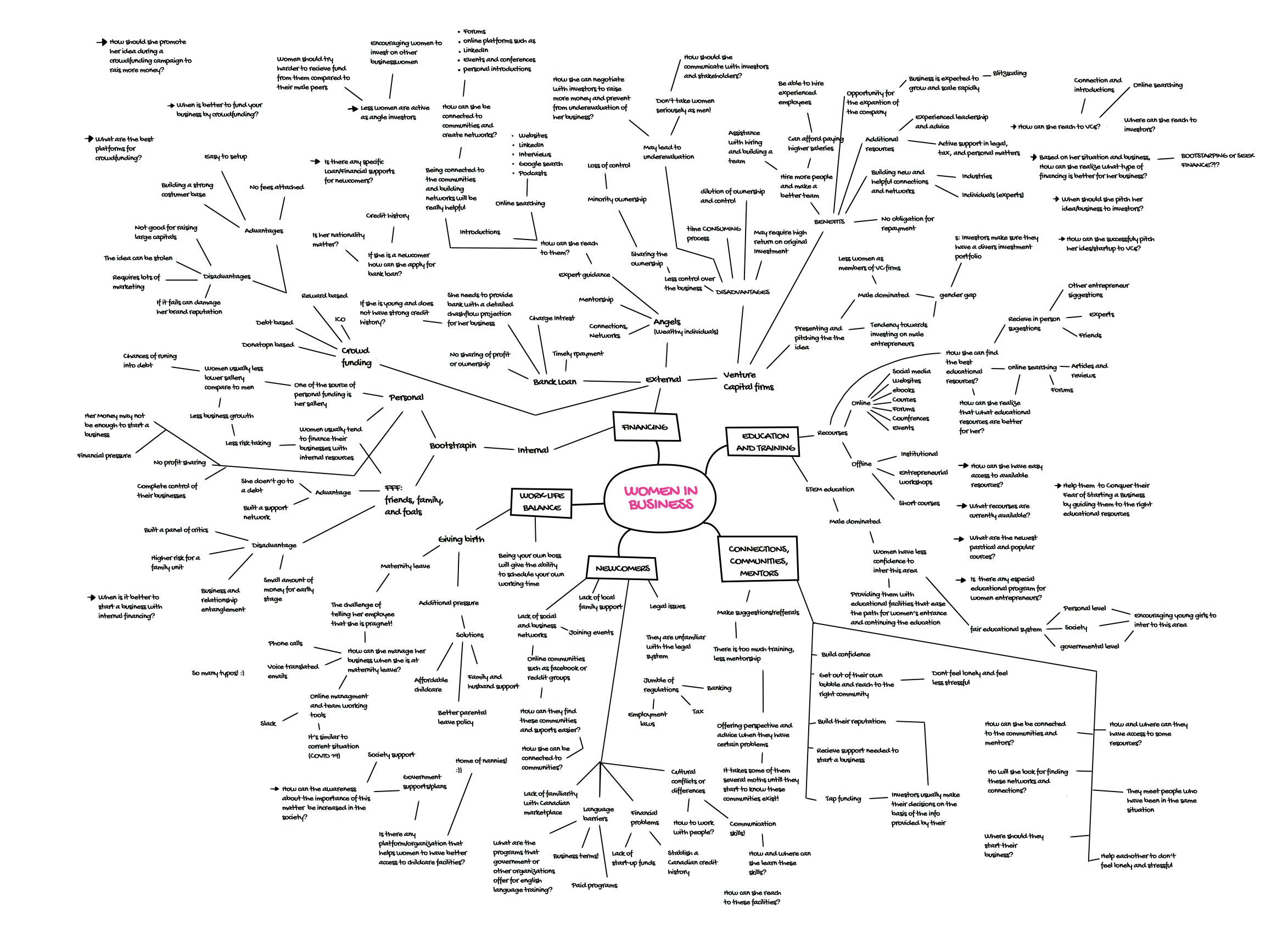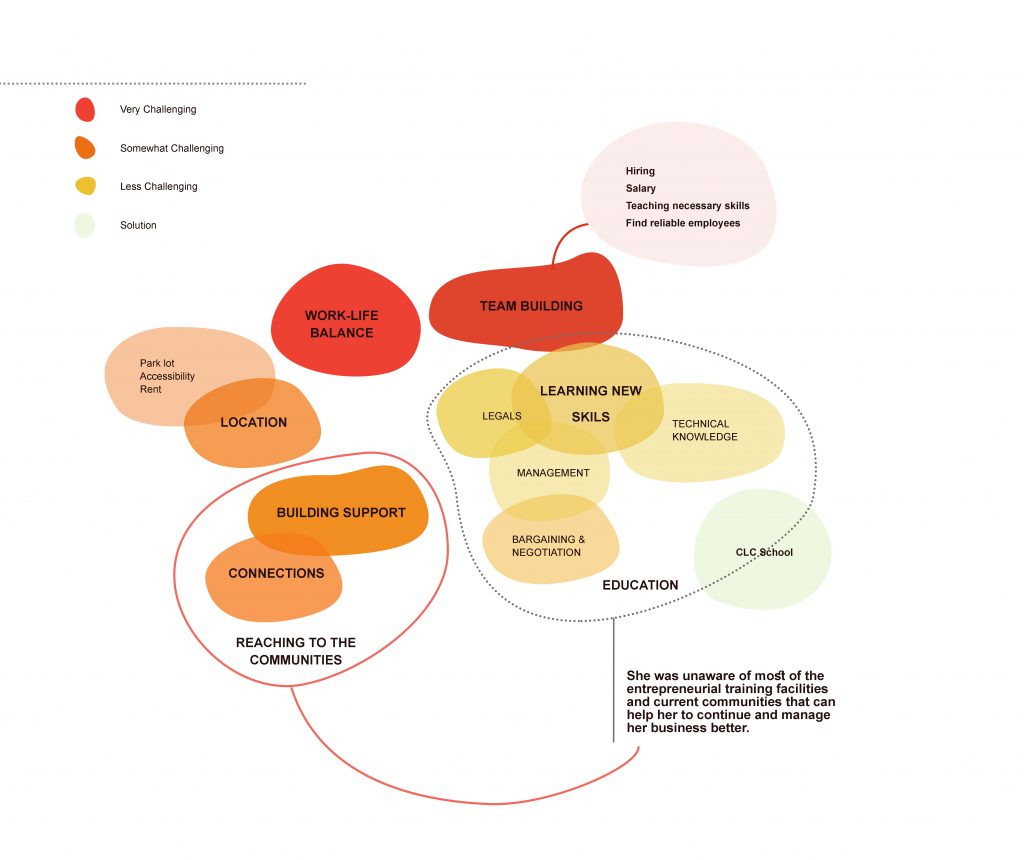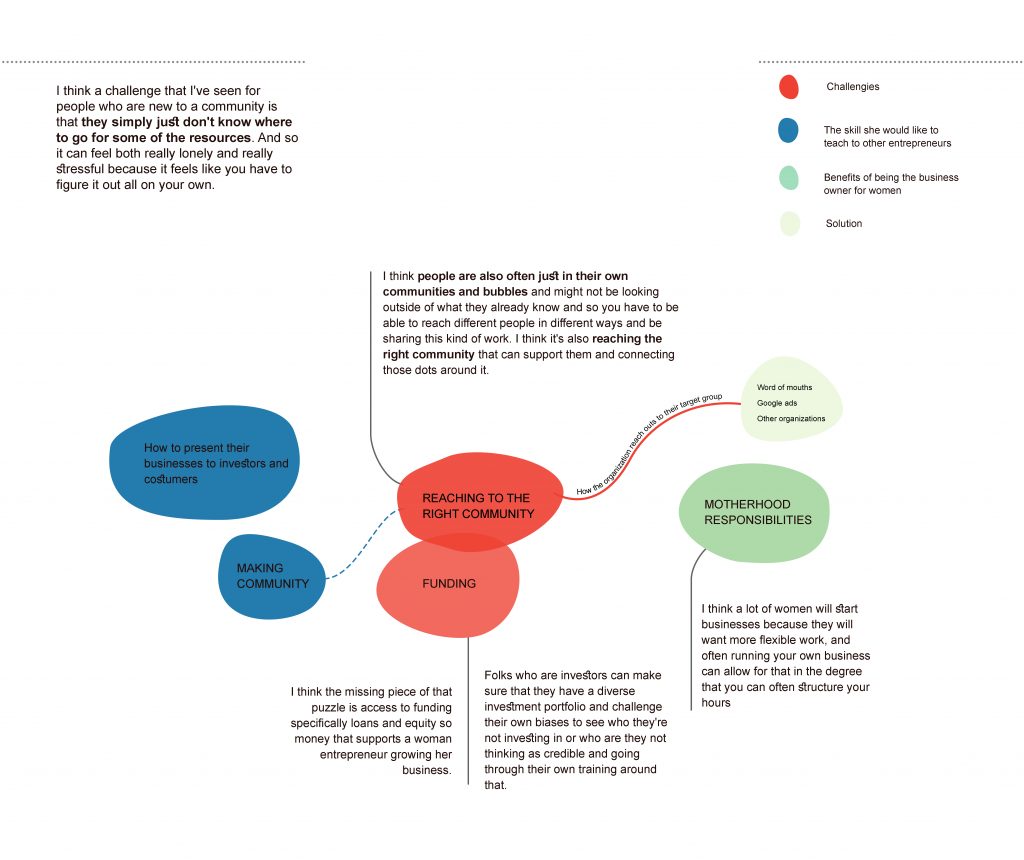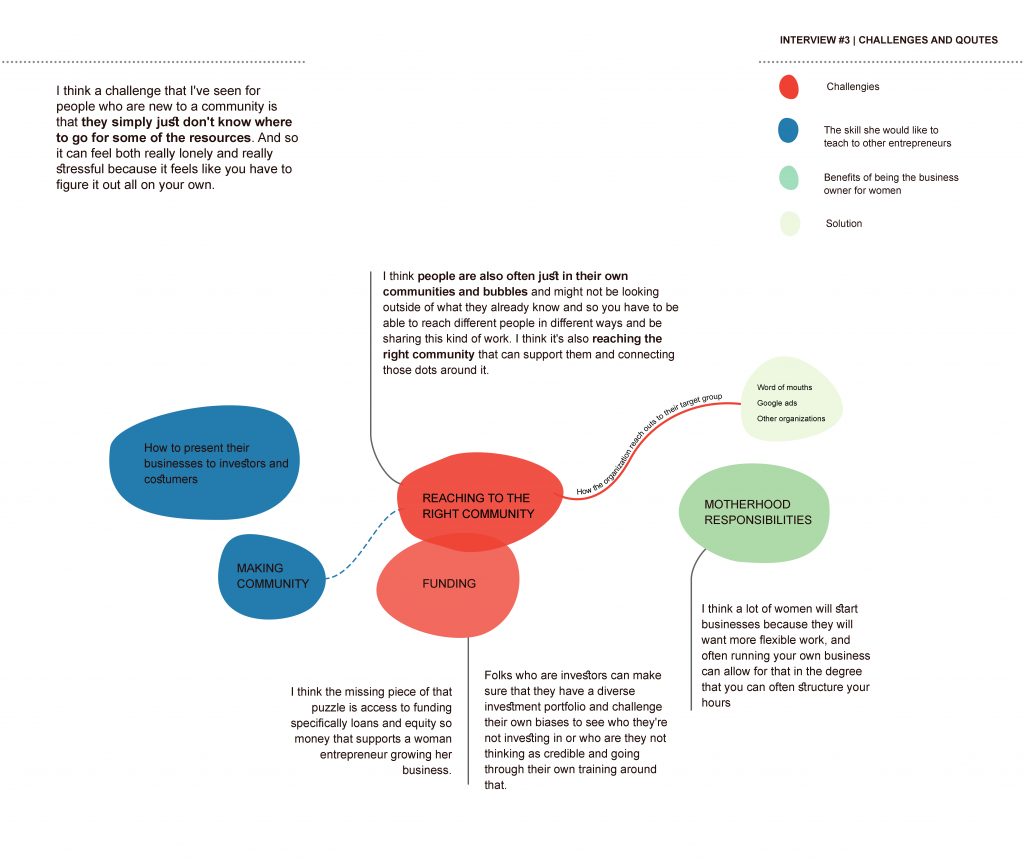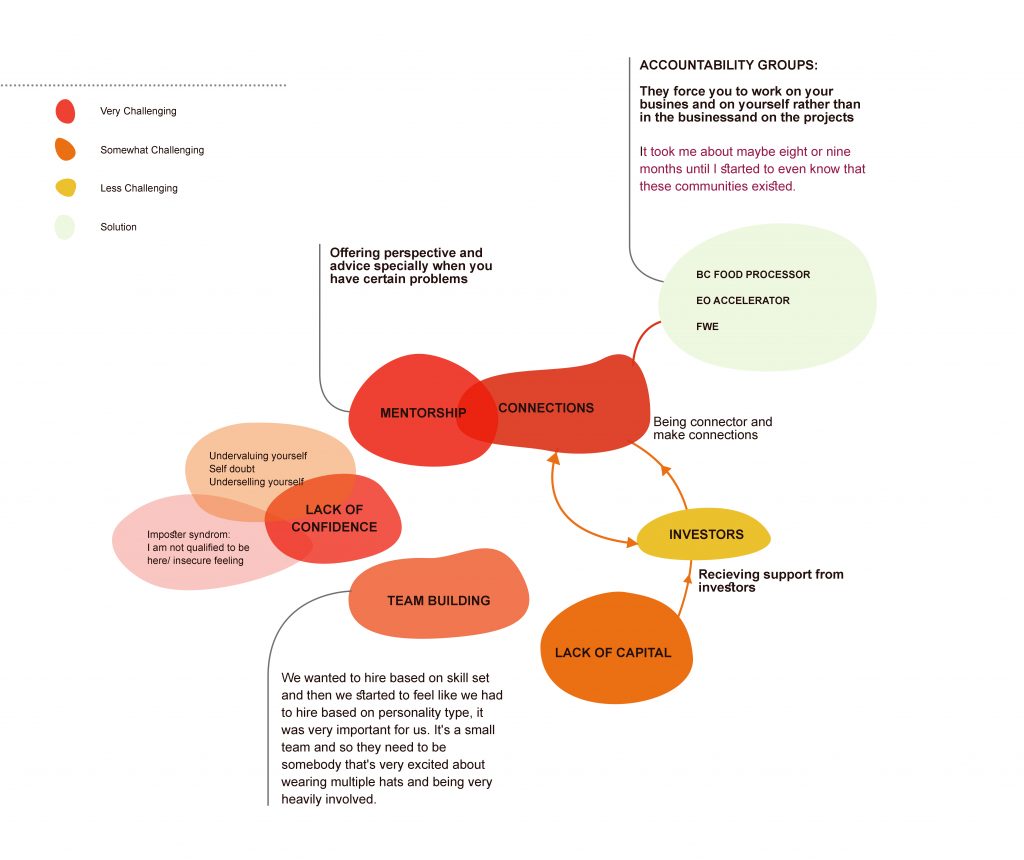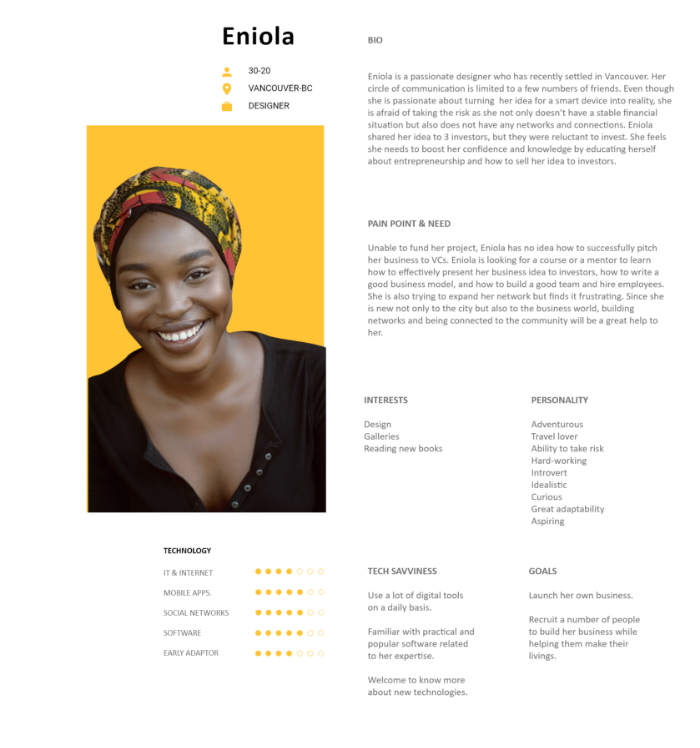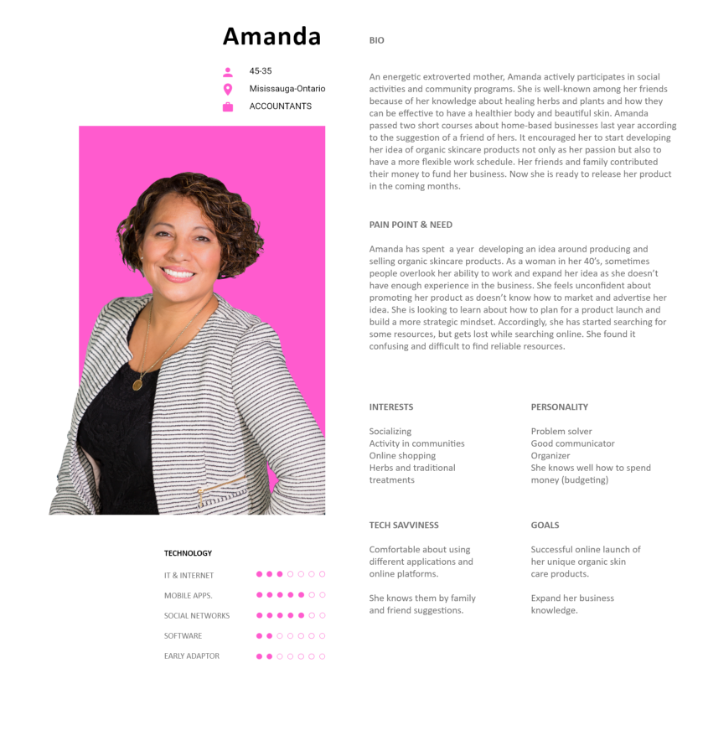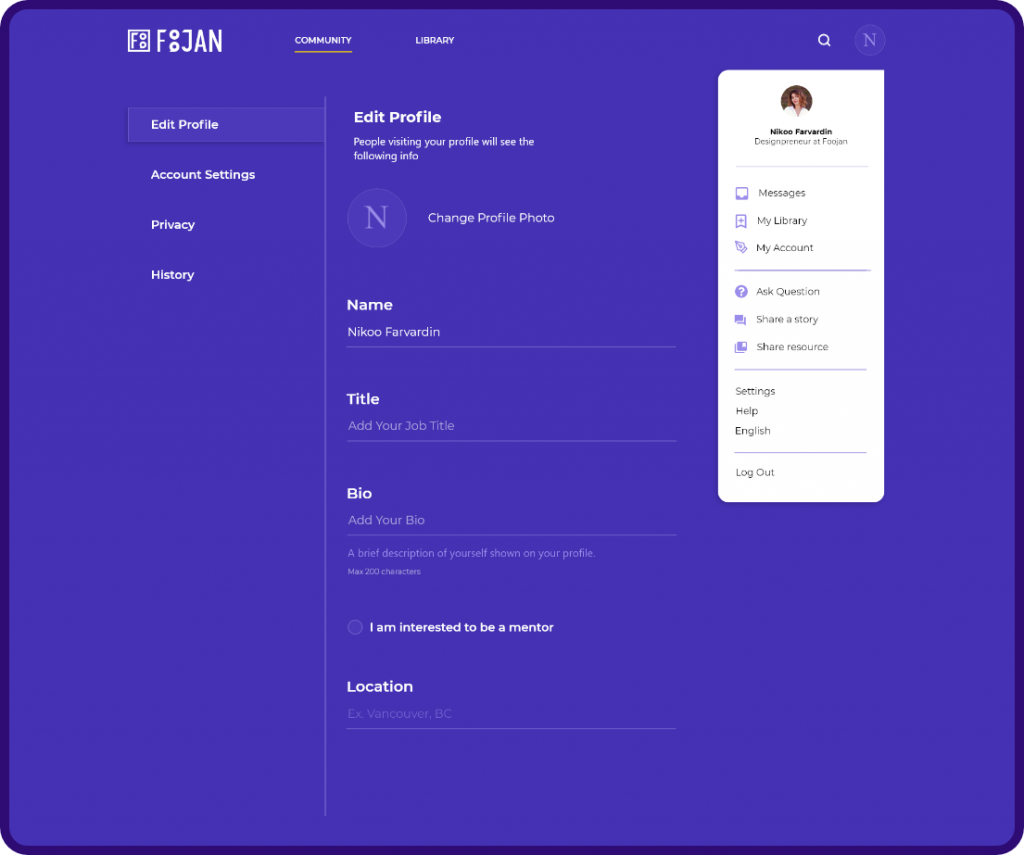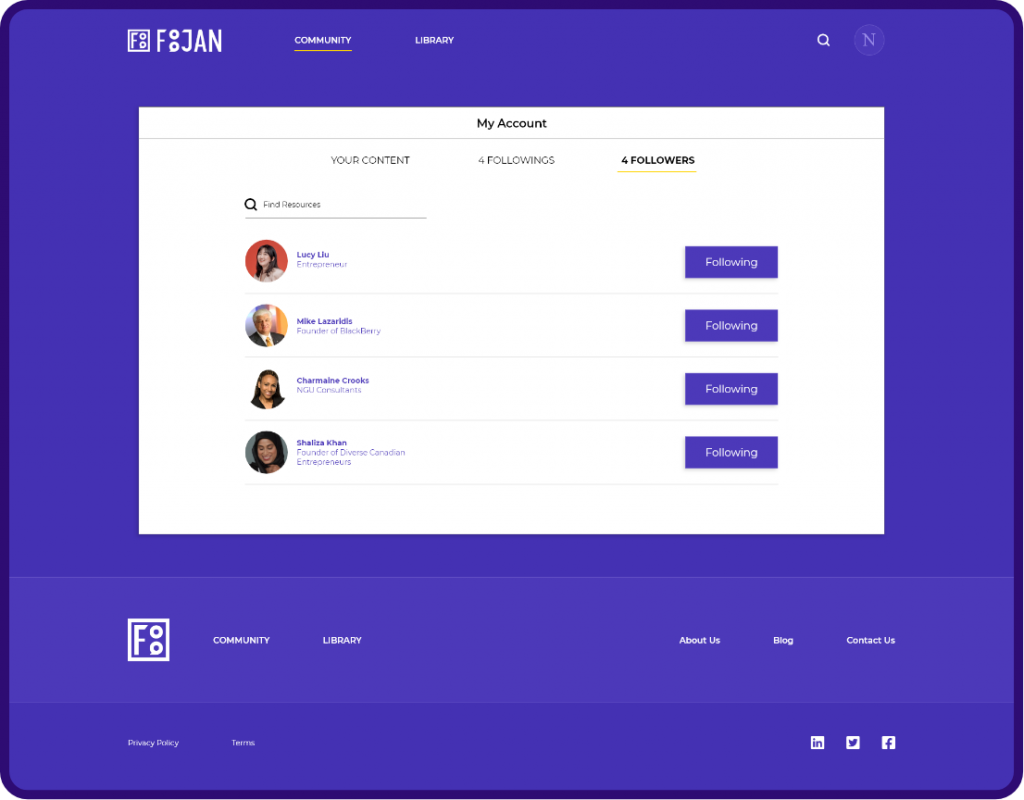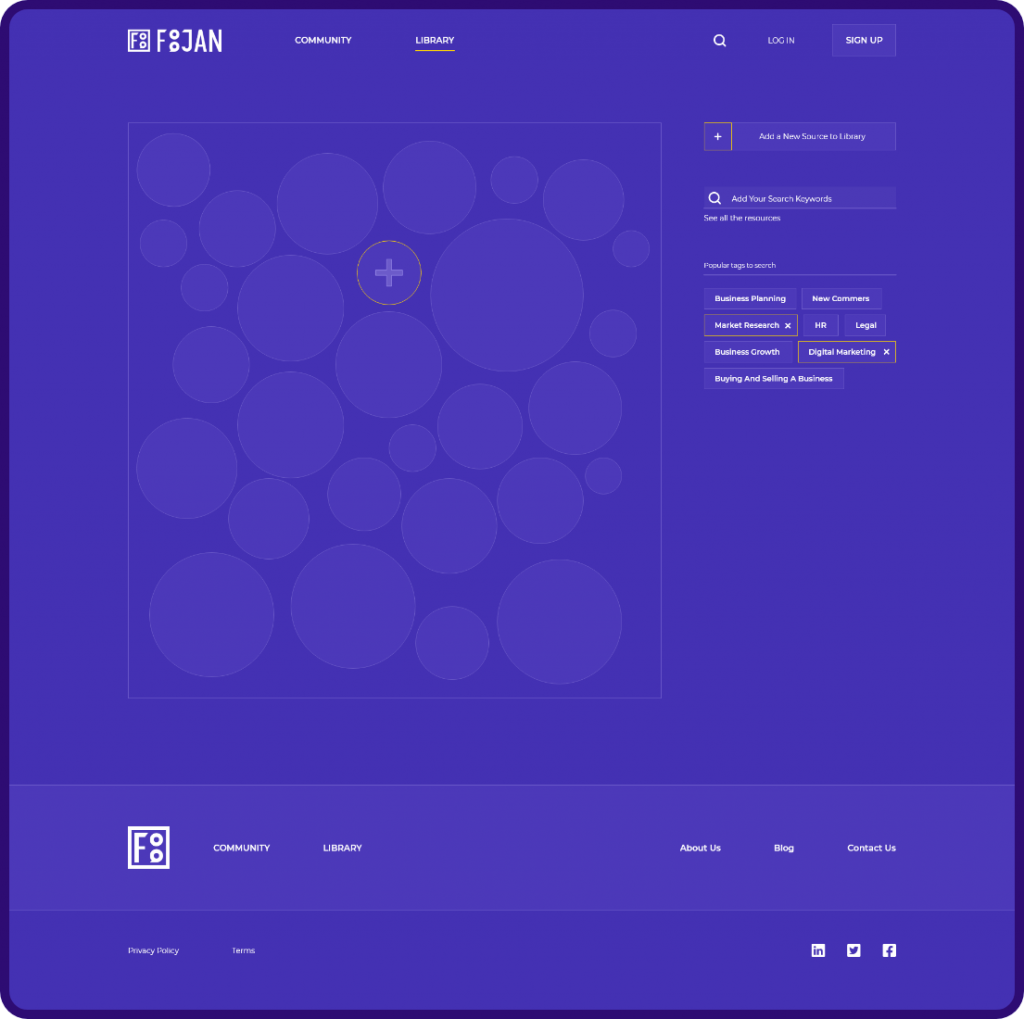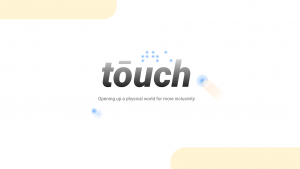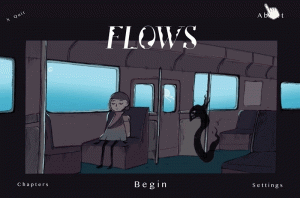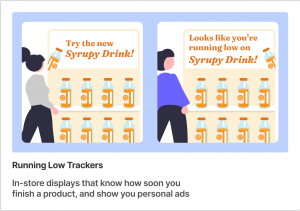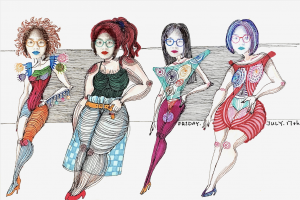More Women in Business
Nikoo Farvardin
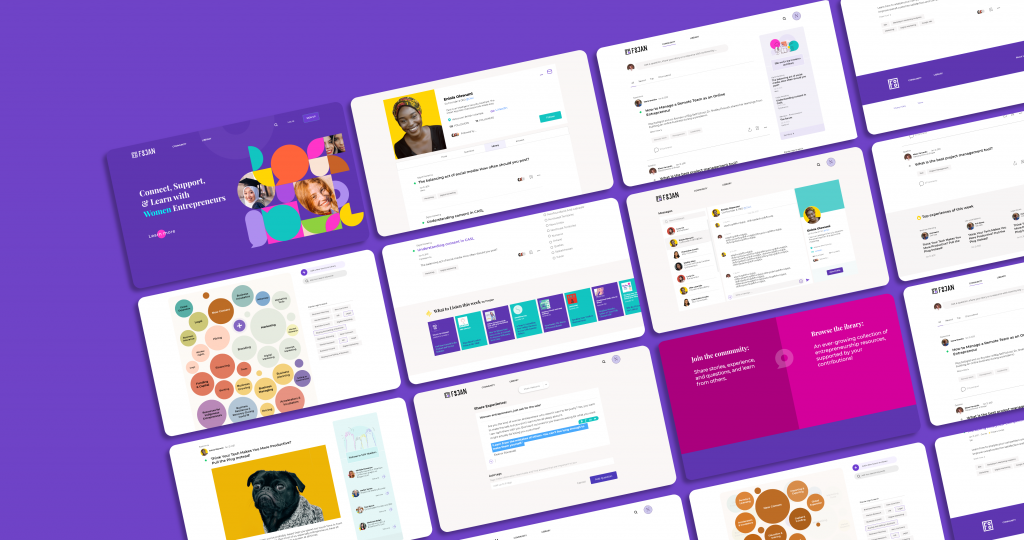
Foojan
A platform to empower women entrepreneurs in Canada
The research and design process for creating a platform for women entrepreneurs
Overview
This project is a design-led investigation into empowering women entrepreneurs in Canada using participatory design methodologies to identify their major problems in and generate appropriate solutions. During the course of this project, two potential opportunities were uncovered:
- A space for women entrepreneurs to connect with other entrepreneurs, share their experiences and ask and answer questions.
- A space to refer to and share entrepreneurship resources.
An interactive and collaborative platform is offered to facilitate communications between entrepreneurs along with a library of entrepreneurship resources accessible to beginners and experienced entrepreneurs alike.
.
Foojan’s Community Features
Questions
What was I looking for?
This project is a design-led investigation into empowering women entrepreneurs in Canada using participatory design methodologies to identify their major problems in and generate appropriate solutions. During the course of this project, two potential opportunities were uncovered:
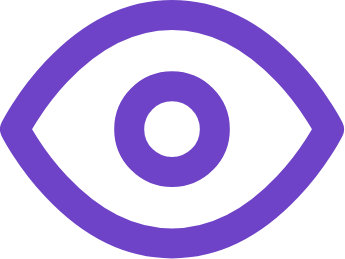
What are the main difficulties for women entrepreneurs before or after launching their businesses?
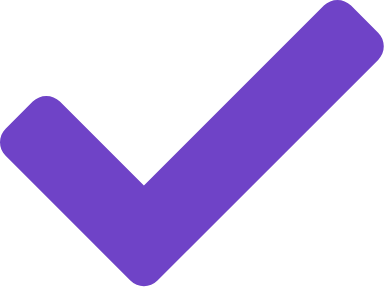
How can women entrepreneurs be empowered to tackle these underlying problems and continue their businesses with fewer obstacles?
Secondary Research
Women Entrepreneurship in Canada
To begin, I went through a number of resources to gain a better understanding of the status of women entrepreneurship in Canada. I took advantage of articles and reports prepared by individuals and reliable organizations such as Global Entrepreneurship Monitor (GEM), BMO Financial Group, Government of Canada, Statistics Canada, Innovation, Science and Economic Development Canada (ISED), OECD, and McKinsey Global Institute.
Secondary Research
Online conversation analysis
Next, I gained insights from entrepreneurs’ stories, needs, and concerns.
By analyzing online conversations, I figured out that challenges for men and women are mostly similar. They usually tend to ask the same questions. In addition, based on the industry that they are active in, their backgrounds, and their experiences, both may face different challenges and look for different solutions. As a result, it was difficult to identify unique challenges for women entrepreneurs based on analyzing forums’ conversations.
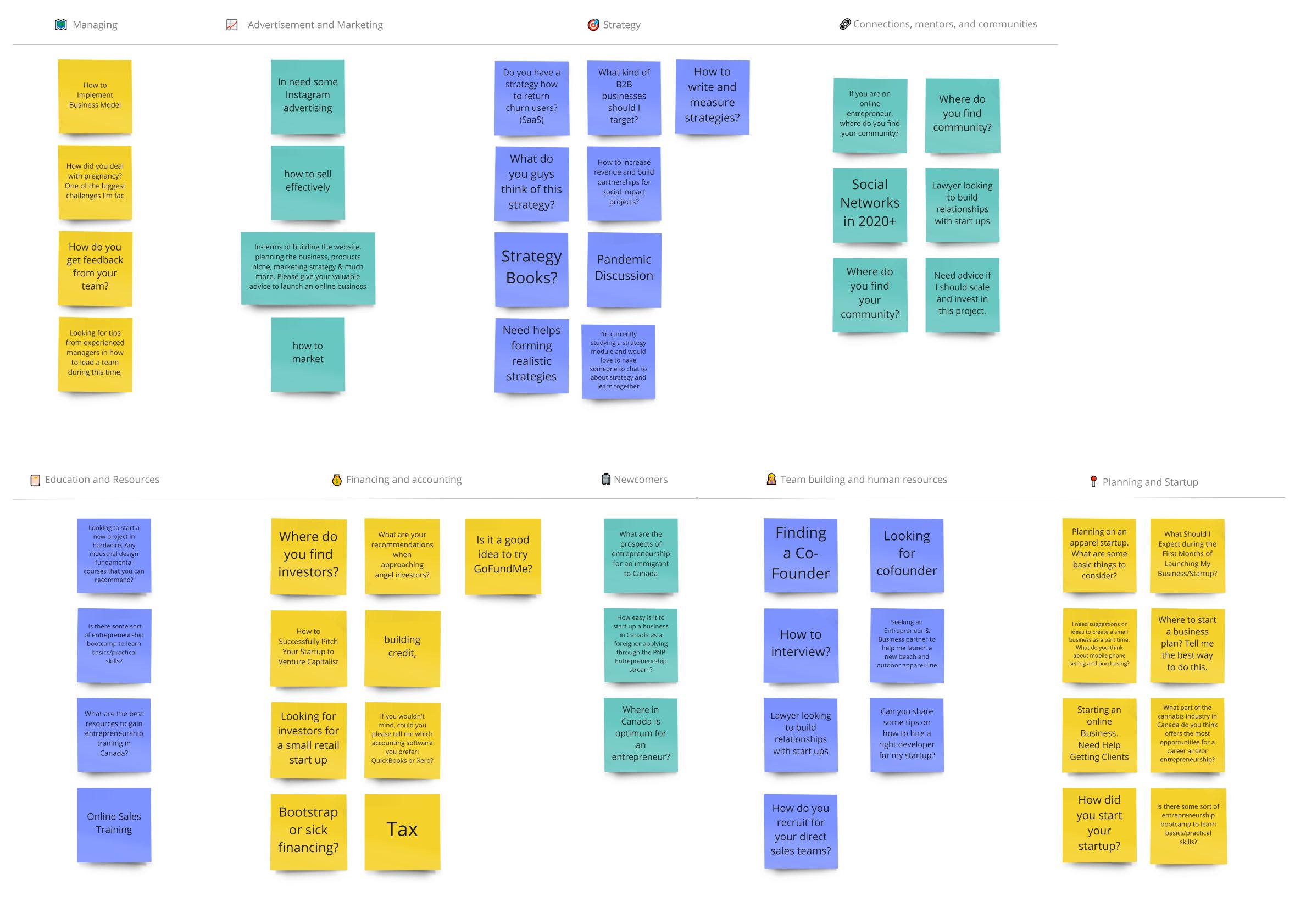
Deep Interviews
Identifying the major challenges
for women entrepreneurs
I used deep interviews to capture the challenges, contexts, insights, and needs of women entrepreneurs. A generative toolkit consisting of challenge and skill cards and sticky notes allowed me to encourage participants to dig into the deeper layers of their thoughts and emotions. It helped build a sense of empathy and shaped dialogues between participants and myself. Due to the unpredicted situation caused by COVID-19, I benefited from online platforms such as Miro and Zoom to conduct some of the collaboration sessions.

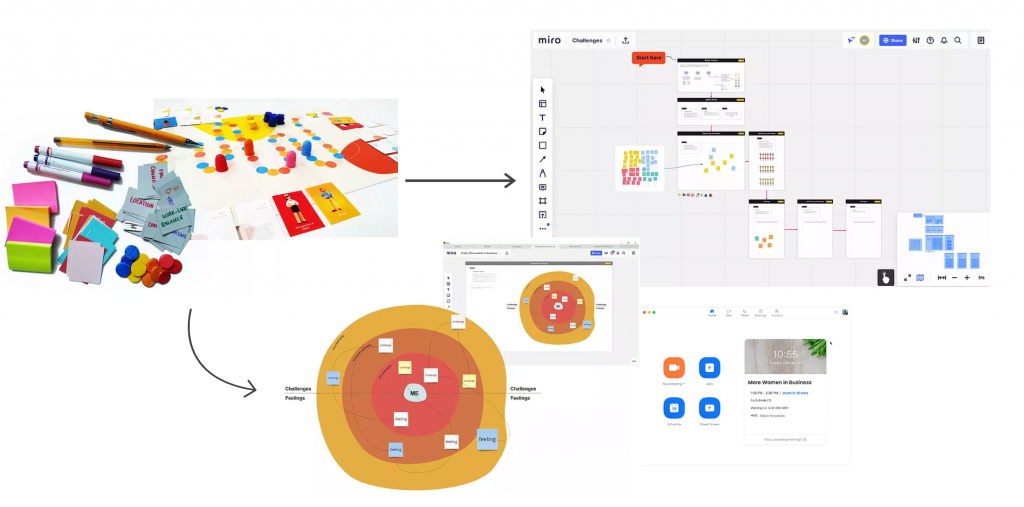
Weighting
Analyzing the result of interviews
Labeling problems based on how participants found them challenging
Throughout the card sorting activity and interviews, participants were asked to label problems based on how challenging they found them. This helped me figure out the main challenges and what matters to women entrepreneurs. Some problems were frequently brought up but their effects on the business were not significant, and women found them less challenging.
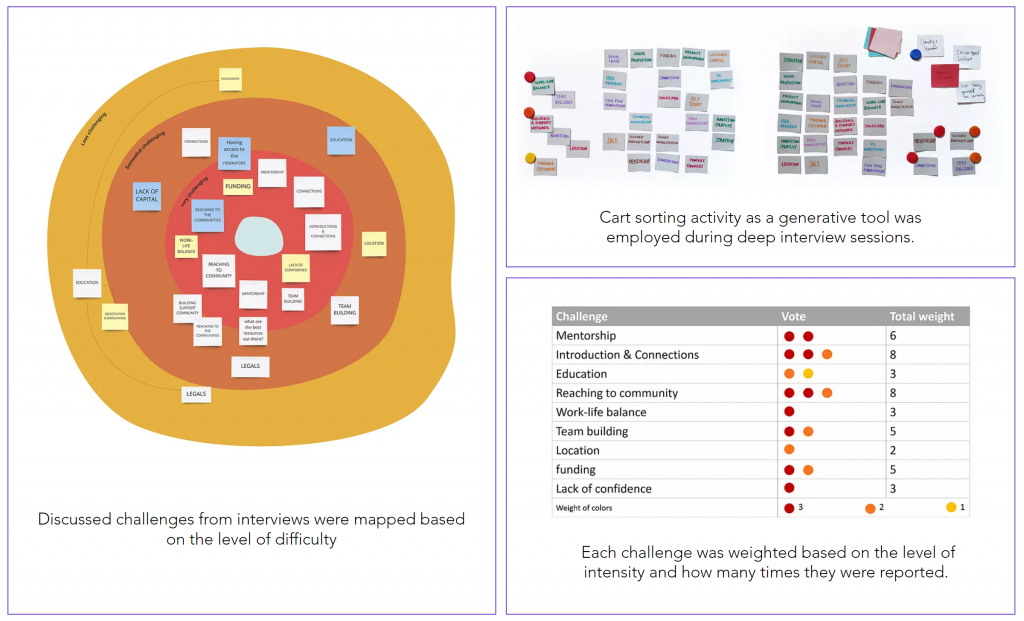
Synthesis
Some important
insights I got from Interviews
After analyzing the result of the interviews, I discovered many challenges and narrowed them down to two general areas: – mentorship and community and easy access to available resources.
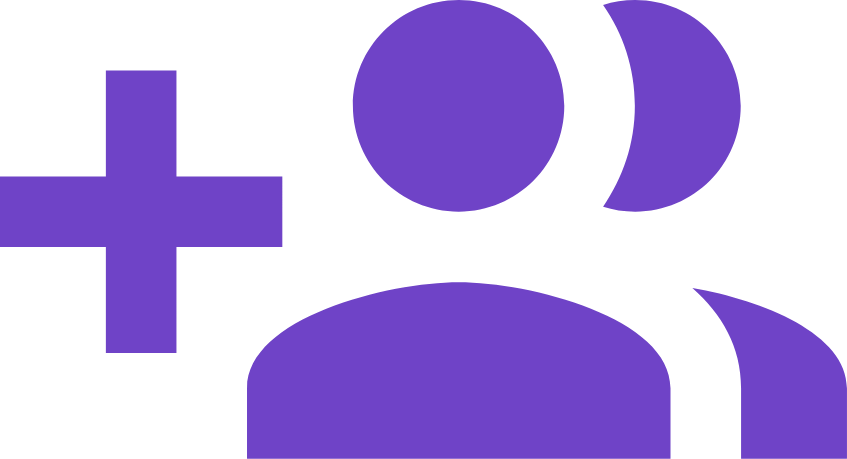
Mentorship and access to community;
Having access to a mentor will have an evident impact on reducing decision errors, creating a strategic vision, and confidence.
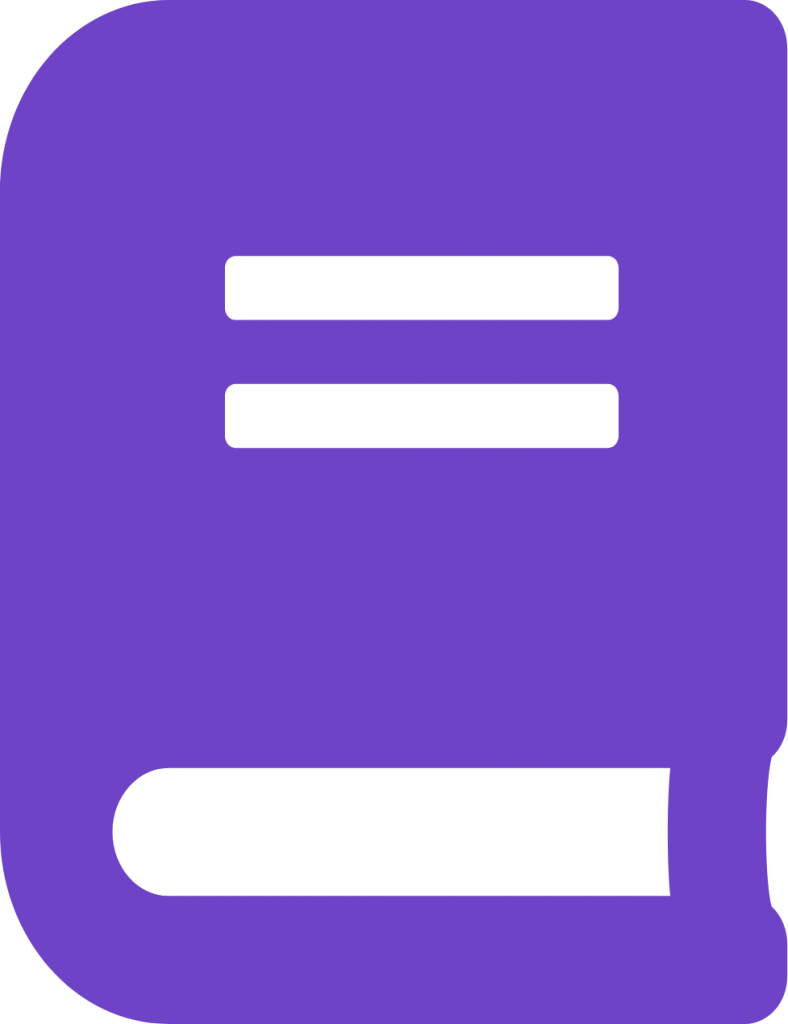
Easy access to available resources;
Some women are unaware of available resources that might help them kick off a business. Finding some of these resources is not easy if one does not spend a great deal of time searching for them.
Target Audience
I wondered who would be the end-users
To develop solutions for the identified needs, personas were created to encapsulate the needs, behaviours, goals, and traits of the target group. This helped to shape a holistic understanding of users and engender a sense of empathy that informed the scope of the design problem and the framework for design.
Personas were synthesized from data collected from deep interviews and workshop sessions. Two different personas were described to reflect a picture of individuals dealing with two main challenges; accessing mentorship and community and finding available resources effortlessly.
User Journey Maps
Exploring the problem space,
mapping experiences
Deep interviews followed by personas provided an excellent context for user journeys. Two journey maps were made based on the personas’ points of view. They demonstrate a clear picture of user pain points and design opportunities. I also leveraged the maps in designing the ideation sessions and what I should discuss with participants during the sessions.
The journey maps indicated a possible connection between mentorship and community. People who access a community have a better chance of benefitting from mentorship. Working with mentors will widen entrepreneurs’ networks and connect them to the community.
.webp)
.webp)
.webp)
Ideation Session
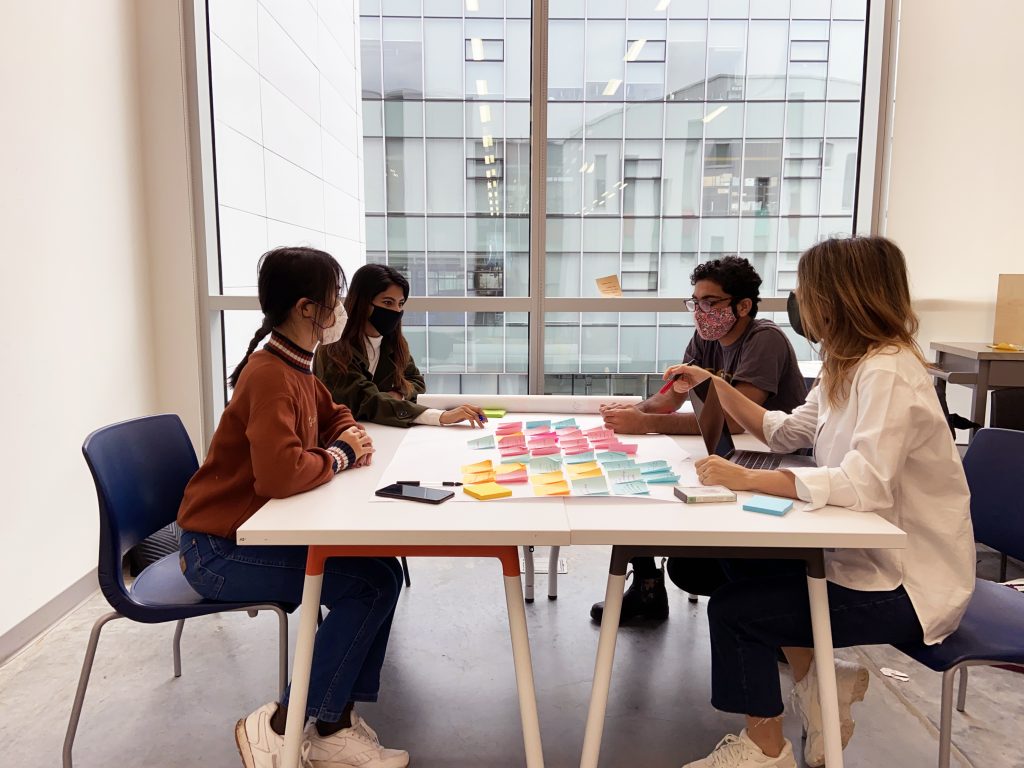
Generating idea with the help of the target audience
In the next step, target groups and creative designers were invited into the creative process. The objective of ideation sessions was to talk about problems and generate possible solutions.

Insights & Outcomes
Developing different ideas based on the ideation sessions’ outcomes
As Verganti says: the best designers not only listen to people but also follow their own reasoning and instincts.
I used the ideas shared by the participants as sources of design inspiration and innovation.
By reviewing and evaluating five final design solutions and reflecting on the outcomes of ideation sessions, I worked on merging, simplifying, and changing some of their features.

Final Design Outcome
Bringing these ideas together in Foojan, an online platform
By reviewing and evaluating five final design solutions and reflecting on the outcomes of ideation sessions, they were merged, erased, and some of their features changed. By considering the value propositions of each idea – pros and cons – a practical solution was generated.
The result was Foojan, a platform to empower women entrepreneurs by providing them with a library of resources while they can be a part of an entrepreneurship community. Women entrepreneurs will have this opportunity to ask their questions from other community members while they can share their experiences.

User Testing and Feedback
Evaluating the final idea by
entrepreneurs and mentors
To evaluate the initial design outcome, a low fidelity prototype was shared with participants –two entrepreneurs and a mentor, and a designer– during collaborative evaluation sessions. These sessions focussed on major features of the platform, how it can be more useful and goal-oriented, and how it can be an active entrepreneurship community from mentor and mentees’ stand view. The low-fidelity prototype gave freedom to participants to iterate the idea and share their thoughts actively.

System Map
Next, I developed a system map to visually show the different actors and artefacts for the platform, along with the relationships between them.

Site Map
The sitemap shows the relationship between pages and provides a clear picture of a site’s content, organization, and navigation.

Mood Board, Color Palette & Logo Design
I worked on the platform’s visual identity, trying to keep it friendly but also professional. Foojan is a Kurdish name that describes a loud voice that everyone can hear. This name is fitting for a platform that listens to women entrepreneurs and provides a space for them to be heard.

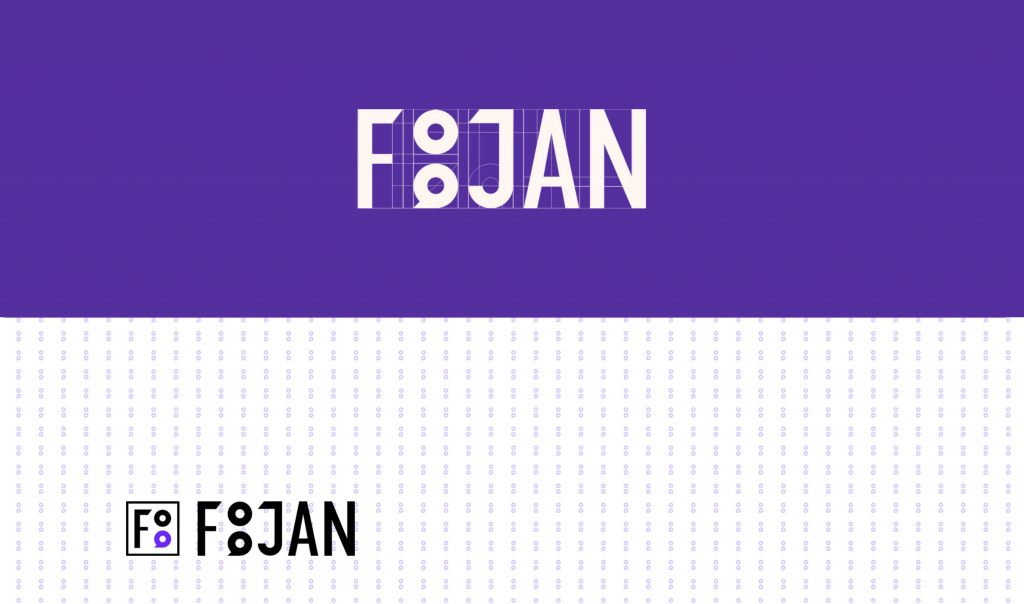
Sketches

Wireframes
The main page of the Library
An interactive map of different and important topics in business using filters to find the most relevant results that users are looking for. The map will change based on the selected filters. When one clicks on a circle on the map, they can see subcategories.

Library’s search result page
After collecting a specific category, users can see all the available resources. Users can apply filters such as newest and top to search through resources easily. They can add resources to their personal libraries by marking resources.

The community page – a space to build connections and share knowledge
Here, entrepreneurs share their experiences, knowledge, and their questions with other community members. So one can learn a lot from others’ experience and their suggestions. Community members can reach each other to build connections based on their expertise or region.

Following and followers pages, Member’s profile to view, and the message page
Community members can reach each other to build connections based on their expertise or region

Enabling mentorship
If someone is interested in mentoring women entrepreneurs – regardless of their gender – they can indicate that by adding a mentorship tag in their Profile Settings page.

Friendly tools for effective sharing
With a simple and user-friendly design to write about an experience, add video, photo, embedded link, and new sections. The tools on Foojan help users to write in a clear and engaging manner.
Each post shared on Foojan needs to be tagged. Tags make information searchable and find answers that are important to you.

Personal library (left) & My account page (right)
Users can create a personal library by bookmarking their favorite resources. They also can create new connections with other women entrepreneurs, so users can reach them when they need their thoughts and insights.

What I learned from this design process:
This project broadened my vision into participatory design where my audiences actively played a role in different phases of my design research — from the fuzzy front end of the design process to generative and evaluative phases. This approach and its challenges taught me that design requires a flexible and strategic approach. One cannot pick a solid plan for the entirety of their process if they want to discover the hidden aspects of the subject of study.
In a nutshell, all the participatory activities in my thesis research aimed to create empathy and a deep understanding of stakeholders. While empathy cannot be achieved without engagement, one can also argue engagement cannot be achieved without empathy. Paying attention to interviewees’ feelings and the context is key to creating a sense of empathy and communicating well with them, which leads to better engagement in the research.

